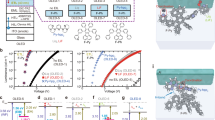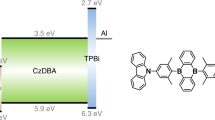Abstract
Considerable effort is being expended on the development of efficient silicon light-emitting devices compatible with silicon-based integrated circuit technology1. Although several approaches are being explored1,2,3,4,5,6, all presently suffer from low emission efficiencies, with values in the 0.01–0.1% range regarded as high2. Here we report a large increase in silicon light-emitting diode power conversion efficiency to values above 1% near room temperature—close to the values of representative direct bandgap emitters of a little more than a decade ago7,8. Our devices are based on normally weak one- and two-phonon assisted sub-bandgap light-emission processes. Their design takes advantage of the reciprocity between light absorption and emission by maximizing absorption at relevant sub-bandgap wavelengths while reducing the scope for parasitic non-radiative recombination within the diode. Each feature individually is shown to improve the emission efficiency by a factor of ten, which accounts for the improvement by a factor of one hundred on the efficiency of baseline devices.
This is a preview of subscription content, access via your institution
Access options
Subscribe to this journal
Receive 51 print issues and online access
$199.00 per year
only $3.90 per issue
Buy this article
- Purchase on Springer Link
- Instant access to full article PDF
Prices may be subject to local taxes which are calculated during checkout



Similar content being viewed by others
References
Bell, P. Let there be light. Nature 409, 974–976 (2001).
Ng, W. L. et al. An efficient room-temperature silicon-based light-emitting diode. Nature 410, 192–194 (2001).
Vescan, L. & Stoica, T. Room-temperature SiGe light-emitting diodes. J. Luminescence 80, 485–489 (1999).
Leong, D., Harry, M., Reeson, K. J. & Homewood, K. P. A silicon/iron disilicide light-emitting diode operating at a wavelength of 1.5 µm. Nature 387, 686–688 (1997).
Hirschman, K. D., Tybekov, L., Duttagupta, S. P. & Fauchet, P. M. Silicon-based visible light-emitting devices integrated into microelectronic circuits. Nature 384, 338–341 (1996).
Zheng, B. et al. Room-temperature sharp line electroluminescence at λ = 1.54 µm from an erbium-doped, silicon light-emitting diode. Appl. Phys. Lett. 64, 2842–2844 (1994).
Schnitzer, I., Yablonovitch, E., Caneau, C. & Gmitter, T. J. Ultrahigh spontaneous emission quantum efficiency, 99.7% internally and 72% externally, from AlGaAs/GaAs/AlGaAs double heterostructures. Appl. Phys. Lett. 62, 131–133 (1993).
Meyer, M. “Craford's Law” and the evolution of the LED industry. Compound Semicond. 6(2), 26–30 (2000).
Planck, M. The Theory of Heat Radiation (Dover, New York, 1959); translation of Vorlesungen über die Theorie der Wärmestrahlung (Leipzig, Barth, 1913).
Kirchhoff, G. R. Über das Verhältnis zwischen Emissionsvermögen und dem Absorptionsvermögen der Körper für Wärme und Licht. Ann. D. Phys. 109, 275–301 (1860) (in German).
Würfel, P. The chemical potential of radiation. J. Phys. C 15, 3967–3985 (1982).
Araujo, G. L. & Marti, A. Absolute limiting efficiencies for photovoltaic energy conversion. Solar Energy Mater. Solar Cells 33, 213–240 (1994).
Würfel, P., Finkbeiner, S. & Daub, E. Generalised Planck's radiation law for luminescence via indirect transitions. Appl. Phys. A 60, 67–70 (1995).
Shockley, W. & Queisser, H. J. Detailed balance limit of efficiency of p–n junction solar cells. J. Appl. Phys. 32, 510–519 (1961).
Luque, A. & Marti, A. Increasing the efficiency of ideal solar cells by photon induced transitions at intermediate levels. Phys. Rev. Lett. 78, 5014–5017 (1997).
Trupke, T., Daub, E. & Würfel, P. Absorptivity of silicon solar cells obtained from luminescence. Solar Energy Mater. Solar Cells 53, 103–114 (1998).
Goetzberger, A. Optical confinement in thin Si solar cells by diffuse back reflectors. Conf. Record, 15th IEEE Photovoltaic Specialists Conf. Orlando, 867–870 (IEEE, New York, 1981).
Yablonovitch, E. Statistical ray optics. J. Opt. Soc. Am. 72, 899–907 (1982).
Campbell, P. & Green, M. A. Light trapping properties of pyramidally textured surfaces. J. Appl. Phys. 62, 243–249 (1987).
Schnitzer, I. & Yablonovitch, E. 30% external quantum efficiency from surface textured, thin-film light-emitting diodes. Appl. Phys. Lett. 63, 2174–2176 (1993).
Windisch, R. et al. 40% efficient thin-film surface-textured light-emitting diodes by optimisation of natural lithography. IEEE Trans. Electron Dev. 47, 1492–1498 (2000).
Green, M. A. & Keevers, M. J. Optical properties of intrinsic silicon at 300K. Prog. Photovoltaics 3, 189–192 (1995).
Zhao, J., Wang, A. & Green, M. A. 24.5% efficiency PERT silicon solar cells on SEH MCZ substrates and cell performance on other SEH CZ and FZ substrates. Solar Energy Mater. Solar Cells 66, 27–36 (2001).
Schlangenotto, H., Maeder, H. & Gerlach, W. Temperature dependence of the radiative recombination coefficient in silicon. Phys. Status Solidi; (A) Applied Research 21, 357–367 (1974).
Wasserrab, Th. Beitrag zur Berechnung der strahlenden Rekombinations-wahrscheinlichkeit B von eigenleitendem Silicium. Z. Naturforsch; Part A 33, 1097–1098 (1978) (in German).
Ong, T.-C., Terrill, K. W., Tam, S. & Hu, C. Photon generation in forward-biased silicon p–n junctions. IEEE Electron Dev. Lett. 4, 460–462 (1983).
Kramer, J. et al. Light-emitting devices in industrial CMOS technology. Sensors Actuators A 37–38, 527–533 (1993).
Vouk, M. A. & Lightowlers, E. C. Two-phonon assisted free exciton recombination radiation from intrinsic silicon. J. Phys. C; Solid State Physics 10, 3689–3699 (1977).
Neisser, A. Spectral Response Measurements on Silicon Solar Cells in the Range of 1 eV to 5 eV Photon Energy at Different Temperatures. Thesis, Technische Universität Berlin (1998).
Thomas, G. A., Ackerman, D. A., Prucnal, P. R. & Cooper, S. L. Physics in the whirlwind of optical communications. Phys. Today 53(9), 30–36 (2000).
Author information
Authors and Affiliations
Corresponding author
Rights and permissions
About this article
Cite this article
Green, M., Zhao, J., Wang, A. et al. Efficient silicon light-emitting diodes. Nature 412, 805–808 (2001). https://doi.org/10.1038/35090539
Received:
Accepted:
Issue Date:
DOI: https://doi.org/10.1038/35090539
This article is cited by
-
A sub-wavelength Si LED integrated in a CMOS platform
Nature Communications (2023)
-
Wired THz Communications
Journal of Infrared, Millimeter, and Terahertz Waves (2022)
-
Direct-bandgap emission from hexagonal Ge and SiGe alloys
Nature (2020)
-
Towards integrated tunable all-silicon free-electron light sources
Nature Communications (2019)
-
Room temperature magneto-optic effect in silicon light-emitting diodes
Nature Communications (2018)
Comments
By submitting a comment you agree to abide by our Terms and Community Guidelines. If you find something abusive or that does not comply with our terms or guidelines please flag it as inappropriate.



